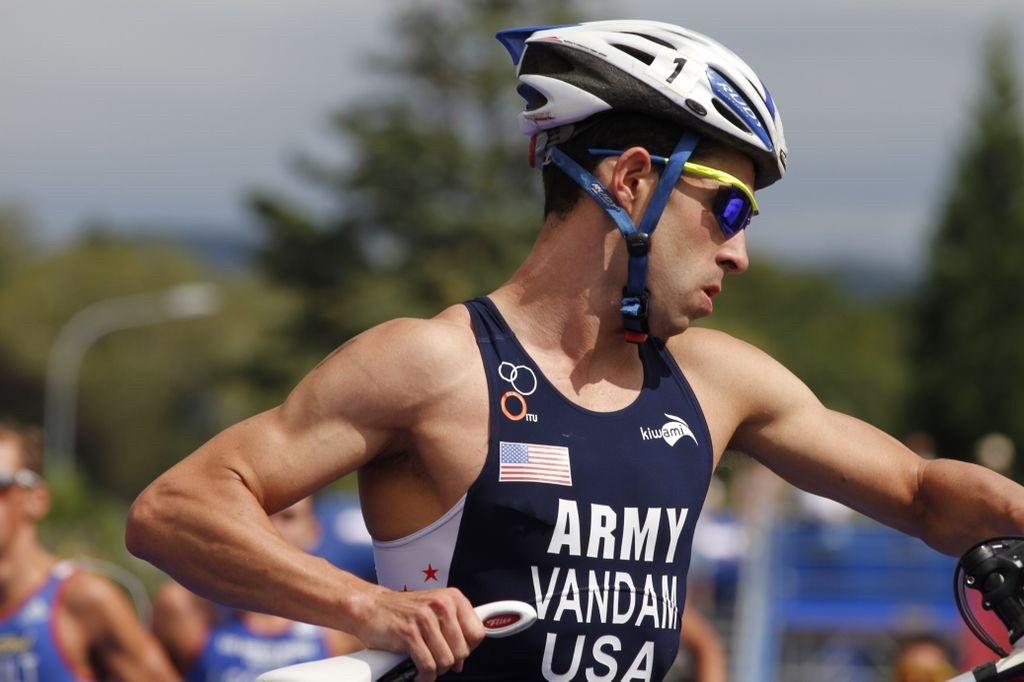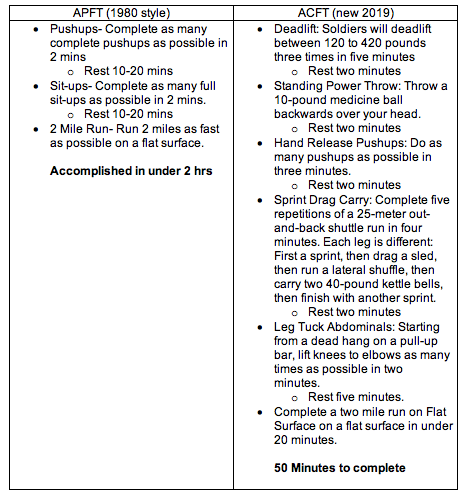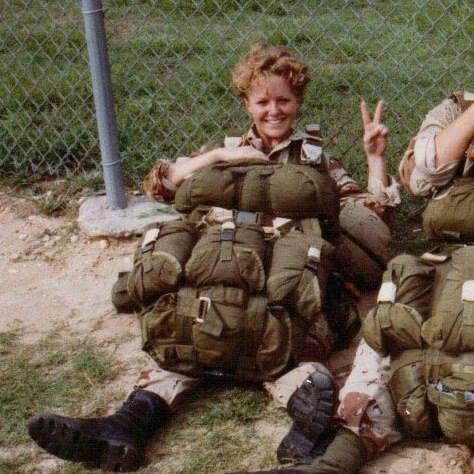The Army soldier’s ‘new and improved’ athletic standard

Nick Vandam competing in the 2012 Military Triathlon World Championship, representing both the Army and USA in Lausanne, Switzerland. (Photo courtesy of Nick Vandam)
As we honor another Veterans Day and Arizona State University celebrates Salute to Service Week, the Global Sport Institute took a look at the new Army Combat Fitness Test (ACFT) that is soon to be implemented by the United States Military come October 2020. In alignment with our 2019–2020 academic theme, “Sport and the Body,” we are particularly interested in how these changes could introduce a new athletic standard for the current and future Army soldier.
The new ACFT will replace the traditional push-ups, sit-ups, and two mile run model that has been in place for nearly 40 years. Some may ask why the change?
According to the U.S. Army, the vision of the restructure is to “Better connect fitness with combat readiness for all soldiers.” The military branch has also said the new and improved test will accomplish and improve upon the four following goals:
- Soldier and Unit readiness
- Transform the army fitness unit
- Reduce preventable injuries and attrition
- Enhance mental toughness and stamina
Despite what seems to be a crystal clear explanation for the recent adaptation, the U.S. military unit’s proposal has since experienced resistance and has generated a considerable debate.
According to the Modern War Institute at West Point, the strongest argument in favor of the new test is it’s “high correlation between the ACFT exercises and demands of ground combat.” The Modern War Institute has also identified the major concerns affiliated with those opposed is the shift in training causing injuries, the high costs derived with fielding the new tests, and the magnification of issues it will run into with other units of the military where the test’s longer duration will intersect with limited mobilization hours and widely distributed units; they noted a direct conflictwith the National Guard and Reserve.
First up, we asked Nick Vandam, an active U.S. Army Reserve Captain, ASU & Thunderbird student, and 2019 Global Sport Institute venture winner his thoughts on how the changes may play out. Later in this post, we inquire with Dr. Karen Gallagher, U.S. Army veteran, Tillman Scholar, and Senior Postdoctoral Research Scholar for the Global Sport Institute.
GSI: First, give us a brief background of your military experience and how it crossed over with athletics?
Vandam: I joined the military in 2005 when I was recruited to swim at West Point. From there, I migrated into triathlon as I discovered I was better at triathlon than swimming itself. I graduated in 2009 and made it on to the Under-23 World Champs team, which led into a National Team spot. I went on to compete around the world, representing both the U.S. and Army. It was a great honor to represent the U.S. across five different continents as an athlete.
In 2011 while racing in Japan I had a heat stroke, which put an end to any dreams of London 2012. After that injury I returned to a more traditional role in the Army as an Operations Manager (if you’re in the Army its also known as the purgatory of a S3 shop). I recovered and ended up having the best season of my life in 2012, winning military national championships and placing 10th at the World Championships. I eventually found my way to Afghanistan, where I deployed in support of Operation Enduring freedom from 12'-13'.
At that point in my life, I would say my “bubble” of triathlon burst very quickly when I arrived in the country. I was forced to grow up fast. It was a healthy process for me to think beyond swimming, biking, and running. In 2014, I got out of the active Army, and after a break in service, I returned in 2017 to the Army Reserves as a Psychological Operations Officer.

Nick in Afghanistan completing the his one year tour in 2013. (Photo courtesy of Nick Vandam)
GSI: How will the reformatting of the new Army Combat Fitness Test affect your current role?
Vandam: I am looking forward to a more accurate standard to test Soldiers and myself. I have never had to practice for the Army Physical Fitness Test (APFT), but honestly, I feel I need to get in shape for the new Army Combat Fitness Test (ACFT). The mission of the US Army is to fight and win America’s wars, and to do that, the Army needs to continually strive to be the best-trained force in the world to be able to do achieve that mission.
It’s the same culture of many large organizations such as Amazon, always striving to be better and improving themselves. At Amazon, it’s a matter of delivering packages faster or improving the variety of options you can buy online, well for the Army it’s a matter of defense of the nation, which is potentially direr than package delivery. The Army needs to be the most capable it can be to accomplish this mission for the American people. I believe we are going to have more capable Soldiers through this new test, which is the fundamentals of achieving victory in combat.
GSI: Do you think the changes to the nearly unamended test are necessary?
Vandam: The APFT as the Army knows it today, 2-mile run, 2 mins of pushups, 2 mins sit ups (full) was put in place in 1980. That was a very different time in the US and Army; we were recovering from Vietnam, and the Cold War was in full swing. That was a very different time in fitness as well. Jim Fixx had only published the bestseller “The Complete Book of Running” in 1977. So at the time of 1980, I am sure the APFT was a very innovative program and I am sure many Soldiers were in shock. “Your going to test us on a full 2-mile run!, what are we Olympic athletes now?” It makes sense, though, soldiers in combat should be physically fit. For thousands of years, Soldiers have had to trek across continents through horribly severe conditions to arrive at a place and fight and win in combat, where it was quite literally to the death. That physical and mental endurance requires a high level of training and fitness for each Soldier.
Now the Army is at the point nearly 40 years later where it is evaluating if this initial fitness assessment still is the right measuring tool to judge someone’s capability to fight combat. I would venture to guess, no it is not a great assessment. But that’s what the Army uses because it’s better than nothing. Never have I been shot at and then in response gotten down and done full sit-ups in response. Though, there is a correlation between Soldiers that are disciplined to stay in shape with the quality and discipline in other aspects of a Soldier.
The new ACFT is an evolution of that fundamental principle that the U.S. Army needs physically fit Soldiers in combat. The unique part about the ACFT is that it evaluates Soldiers’ neutrally in regards to gender and age, but it does require minimum scores for specific types of jobs. Infantry Soldiers have different physical requirements than Soldiers that are in human resources. But that HR Soldier still needs to have a base level of capability in combat. Bullets don’t care what your job is or your gender or age. They are as unbiased as they come. To be capable in combat no matter who you are, you need a basic level of fitness.
You decide for yourself what you think is a better indicator of physical fitness for combat?

Source: https://citizen-soldiermagazine.com/the-new-standard-of-fitness/
Deadlift - This lift replicates picking up ammunition boxes, a wounded battle buddy, supplies or other heavy equipment.
Standing Power Throw - This throw measures the muscular explosive power needed to lift oneself, or a fellow Soldier, over an obstacle or to move across uneven terrain rapidly.
Hand Release Pushups - These alternative push-ups are meant to assess the type of upper body strength needed to push away during evasive maneuvers.
Spring Drag Carry - Simulates pulling a battle buddy out of harm’s way, moving quickly to take cover, or carrying ammunition to a fighting position or vehicle.
Leg Tuck Abdominal - This test measures core muscle strength.
GSI: What do you see occurring if there is significant push back?
Vandam: There are issues going on that the Army is trying to work through. Logistics is probably the biggest issue; this requires considerably more equipment, trained graders, and the right environment than the previous APFT. For instance, it is a bit difficult to do this on a forward operating base in Afghanistan or a small Army reserve center away from a large military installation. There is a big focus on how to scale this test and ensure it can be done across the entire Army.
The APFT is a staple in the Army, and any change to that 39-year-old test will be difficult. Change is not easy for any individual, let alone an organization with over 1,000,000 Soldiers. It cannot be understated the monumental muscle movement the Army is undertaking to institute the new ACFT. Think just how many hexagon bars need to be bought to conduct the deadlift in order to test 1,000,000 Soldiers? Undoubtedly, this is an opportunistic time to be a hexagon bar manufacturer.

Another photo of Nick in Afghanistan serving his country overseas with fellow soldier and friend, Rob Bauleke. (Photo courtesy of Nick Vandam)
There is a quote by an unknown German General from a Post WWII briefing that I think is somewhat appropriate in this situation: “The Reason the American Army does so well in wartime is that war is chaos, and the American Army practices it on a daily basis.”
There will be growing pains, and I don’t know how it will roll out, but initially, it will be difficult. The Army is used to this type of work, and it’s another opportunity for leaders to execute Mission Command training as it will be a bit chaotic to implement.
To add to Nick’s insights and gain a holistic understanding of the implementation of the ACFT across the U.S. Army, we inquired what these changes might mean for females, by asking Global Sport Institute’s Senior Postdoctoral Research Scholar Dr. Karen Gallagher to weigh in. Dr. Gallagher is also a U.S. Army Airborne Gulf War 1 veteran where she deployed with the 35th Signal Brigade as a chemical specialist.

Karen Gallagher, then a paratrooper, preparing for a training jump at Ft. Bragg, NC shortly before deployment. (Photo courtesy Karen Gallagher)
GSI: What about the new ACFT raises concerns or garners more discussion?
Gallagher: One thing that immediately comes to mind is that there were initial unofficial reports (leaked by WTF Army) of early tests of the ACFT showing significantly higher failure rates for females compared to males (84% failure for females vs. 30% for males).
However, those were based on test runs of the ACFT where soldiers did not have full understanding or experience with it. Soldiers were still training the ‘old way’ to meet the current standard.
GSI: What are some key differences between male and female training standards?
Gallagher: As more information emerges and understanding of the ACFT increases, units piloting the test are reporting significant decreases in failure rates because now soldiers, male and female are training differently:
- The leg lift test requires core and upper body strength in a way that hadn’t previously been assessed and may be harder for women to achieve without specified training.
- Given that the U.S. military cannot function without women, and we have women breaking barriers in infantry and special forces, it is likely that with opportunity and experience, we will see female soldiers rise to conquer this test.
As noted, running was new when the old PT test was introduced in 1980, just two years after the Army abolished the Women’s Army Corps (WACs), there were many challenges to integrating women into the Army and struggles with physical fitness standards.
By the time the late 80s rolled around, Army Soldiers like me met standards to become Paratroopers, and maxed the PT test according to male standards.
GSI: It sounds like there may be some challenges to contend with. What is your overall outlook?
Gallagher: As in every other industry where women have only had recent access, once given the opportunity and the proper training, women rose to the physical challenges and exceeded the standards. Once training is modified to more specifically train upper body and core strength, women will continue to rise and meet that standard as well.
About Dr. Karen Gallagher:
Dr. Gallagher is a U.S. Army Airborne Gulf War 1 veteran where she deployed with the 35th Signal Brigade as a chemical specialist. She is a Senior Postdoctoral Research Scholar for the Global Sport Institute at Arizona State University, a U.S. Army veteran, and a Tillman Scholar. Her work focuses on service-related conditions and transition in military veterans. Her current research focus explores parallels between veterans and athletes in wellness, cognition, and empowerment in the post-sport journey.
About Nick Vandam:
Nick graduated from the U.S. Military Academy at West Point, whereafter he served as an officer in the U.S. Army for five years earning a Bronze Star with a combat tour in Afghanistan. During that time he also was a professional triathlete in the Army’s World Class Athlete program racing on the US National team. He is currently continuing to serve in the US Army Reserves as a Company commander of a Psychological Operations company and holds the rank of Captain. Nick is part of the Global Sports Institute at ASU as a founder and will be graduating Thunderbird School of Global Management in Dec 19’.
To learn more about Dr. Gallagher, see her biography below and check out her most recent opinion piece on the recent intersection of sport & patriotism.
To learn more about Dr. Gallagher, see her biography below and check out her most recent opinion piece on the recent intersection of sport & patriotism.
To learn more about Nick Vandam, see his biography below and visit his Global Sport Venture winning project’s website.
For more content that goes beyond wins and losses, head to globalsportmatters.com.
The Global Sport Institute cares for the health and safety of all its readers. If you are having thoughts of hurting yourself or need someone to talk to, please take action now by calling 1-800-273-8255 or by visiting suicidepreventionlifeline.org. For other resources, visit the Mental Health Resources Guide.